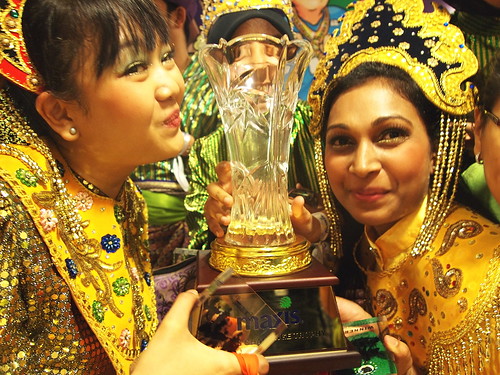I would not be writing a full review of the E-P2 this time around. The upgrade from E-P1 was minimal and mostly focused on the EVF support; to challenge the Panasonic GF1.
Knowing that I was to cover a Talent Contest Thursday, this was to be the best test I could do to the E-P2 attached with the VF-2. In stark contrast, the main camera I was using to cover the event was the E-30 with the twin kit 14-35mm f2.0 and 35-100mm f2.0 lenses.
Comparatively, the limitations on the E-P2 were apparent; slower AF speed, slower lens speed, and a lack of a practically usable flash for the event (It was obvious that my intention was to use the VF-2; thus, occupying the hotshoe). My aim was to see how the VF-2, the latest addition to the Pen stable, fared in near darkness (I am talking about EV range as low as 2 or 3).
In general, the VF-2 was of high quality construction. The round shaped eye-cup along with the sliding diopter adjust lever convey Olympus' commitment in providing the best accessories into the Pen series.

The AF is quite snappy in good light, i.e. EV9
14mm, f/3.5, 1/30s, ISO800, -0.3ev
A quick scan at the specs, I noticed that the VF-2 refresh rate was at 60Hz or 1/60s with a resolution of 1.44MP. What this means was that in order for me to use the VF-2 without noticeable movement bleed, the motion should not be in excess of 1/60s. Somehow, I already sensed that this will be a challenge. In typical human motion, to freeze action takes shutter speeds in excess of 1/125s. It would be an interesting observation, definitely.
With the E-P2 permanently slung around my neck, and the E-30 with either attached 14-35 or 35-100 permanently held, I got the show covered. Sitting just mere feet from the stage, I had a close view of the contestants. Somehow, I found the working space was ultimately cramped, with only about 3 feet of space for me to work around from the front of the stage to the barrier at my back. Just imagine sitting there for 3 hours to get the shots that matters for the client. And there were 2 other photographers and another videographer jostling for real estate mere 20 feet in length. Talk about claustrophobia!!
The typical Exposure Value (EV) on the stage was at 4 or 5, and this proved to be a problem with the f3.5-5.6 lens opening. Shutter speed was hovering between 1/30s and 1/60s at ISO800 or more. The AF sluggishness did not help, too. Although adequate for general photography, it was not the tool of choice for this type of event. I noticed that the contrast detection performance was at par with E-P1, if my memory was correct. In all, this was definitely a handicap, and could not match what the E-30 was capable of doing.

14mm, f3.5, 1/40s, ISO1600, -0.3ev
Overall, I found that the VF-2 was capable (just, actually) to cope with the low light shooting at high human form movement; in this case an all out choreographed dance moves. The high resolution coupled with high contrast helped at lessening the motion bleed, such that it did not appear to be visibly very apparent. The magnification was also good, too. I believe this could be better in the near future as the electronics display technology improves.
I am in the midst of trying to record the VF-2 screen using my Canon S90 camera to enable you to see for yourself the experience of shooting with the VF-2. It is very tricky to ensure high quality reproduction, with the need to constantly ensure the S90 lens is permanently attached to the VF-2 during filming. Let see what can I do tomorrow...
Next entry will be on the usage of OM lenses, particularly the longer 135mm f2.8 and 200mm f4.0 with the VF-2 assisting in lens usage and shooting ergonomics.
So, please stay tuned...
1 comment:
tahnks for the review,
i am thinking about to mount the vf-2 on my eos 5d mk ii, do you have any experience? do you know what kind of video signal the vf-2 needs?
thanks,
mikel from berlin, germany
luminanz@gmx.de
Post a Comment